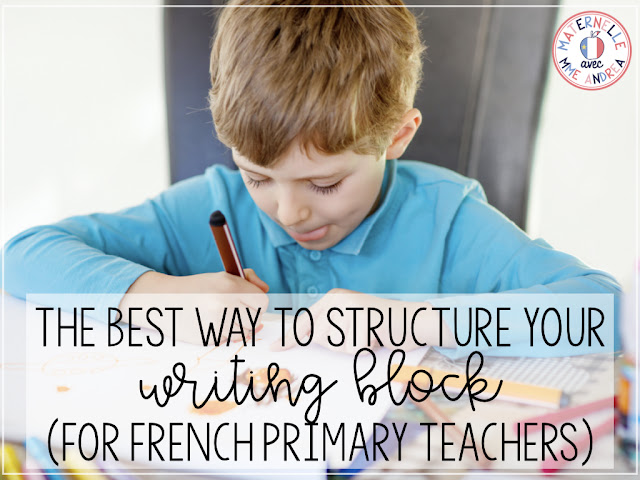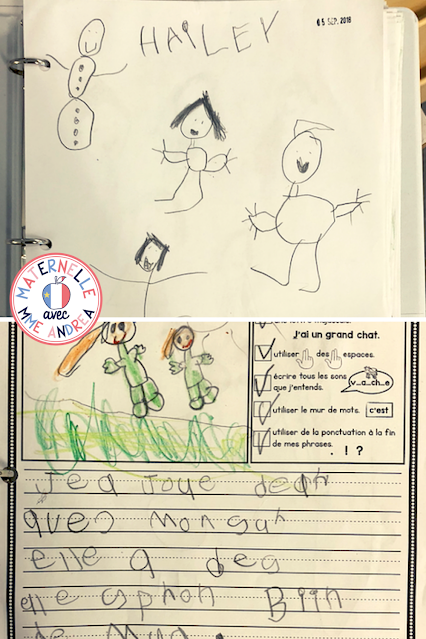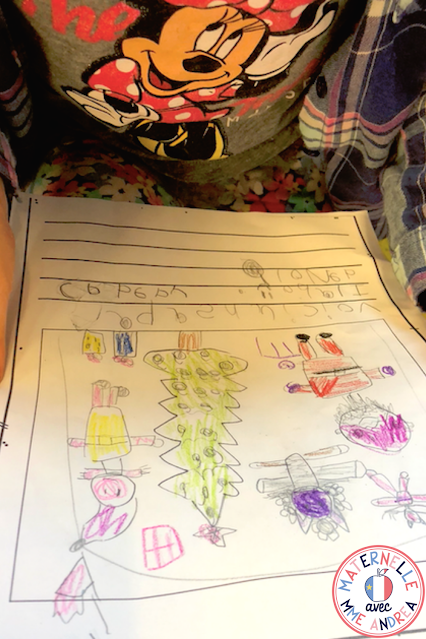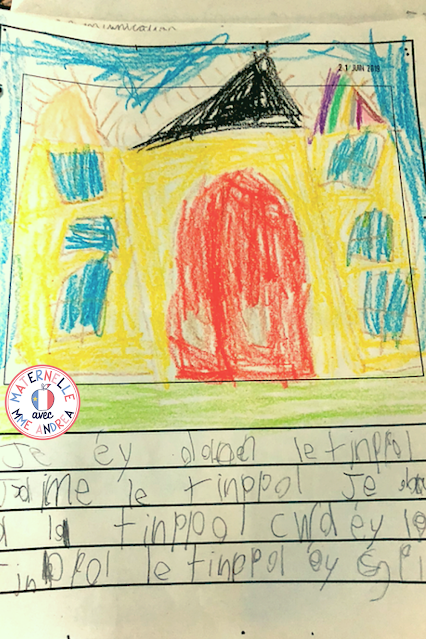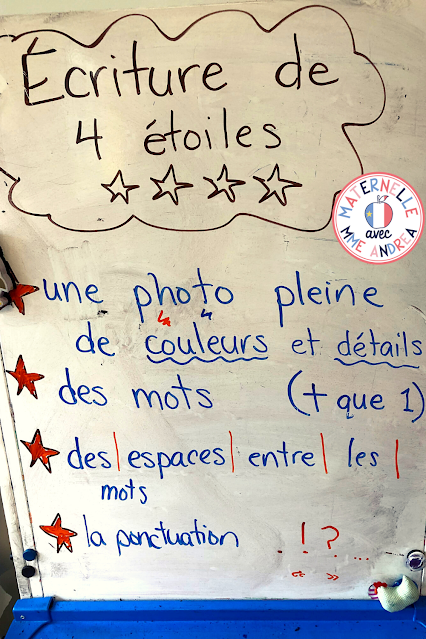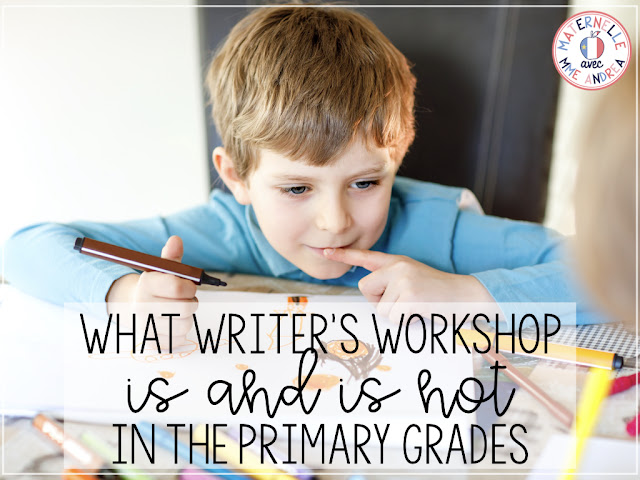How many times have you found yourself diving into teaching writing in the primary grades only to be greeted with lots of raised hands and not a lot of actual writing?
Probably more times than you can count, if you’re anything like me! This post provides an overview of one aspect of a solution to that problem: Writer’s Workshop!
Writer’s Workshop has been a game-changer and a lifesaver in my primary classroom. It’s a way to engage my students in self-directed learning with scaffolding and support in place, and it’s an easy way to keep a structured framework for teaching writing all year round while swapping in different genres and outcomes.
It will be a huge help for you, from an instructional standpoint, and it will be a big support for your students, who will need routine to help them be successful.
In particular, I want to talk about the components of both Writer’s Workshop and the writing process in this blog post.
First, let’s focus on the structure of the lessons and the components of that structure. There are three components here, but one of them can really be split into Part A and Part B, which I’ll get into soon. For now, though, here are those three parts:
- The mini-lesson
- Practice Part A: the Plan
- Practice Part B: the Practice
- The share
THE MINI-LESSON
This is a very important aspect of Writer’s Workshop because this is when you’ll be introducing new routines and procedures and, more importantly, new writing skills for your students to learn.
I only like to spend 5-10 minutes on the mini-lesson, so it’s short and accessible to our young students who don’t have very long attention spans.
During this time, it is essential that you model, model, model and share your thinking as you write — our students hugely benefit from us modelling what we’re asking them to do!
My modelling always focuses on the specific thing I’m asking my students to try in their writing that day.
THE PLAN
You might have already guessed, but this is the pre-writing stage.
Again, I only like to spend about five minutes (or less) on this in my classroom, but it’s really important to get students to think about what they want to write about ahead of time. This way, they don’t waste time doodling. They can actually come up with a plan for the story they’re writing!
One thing I do to help my students is, together as a class, create an ideas brainstorming chart that students can reference when they’re struggling to come up with story ideas on their own.
THE PRACTICE
When you’re first getting started with Writer’s Workshop in your classroom, you’ll want to give your primary students no more than five minutes to write.
Writing is challenging, and our students need to build their stamina for writing for longer periods of time.
Eventually, we work our way up to 25 minutes of writing time — but there’s no rush on this! Pay attention to the cues from your students and let them guide the increase in writing practice time.
Here is an example of how different writing can look at the beginning of the year (5 minutes) versus closer to the end of the year (around 20 minutes), if you let your students build their muscles gradually!
THE SHARE
Of course, with COVID and social distancing or virtual teaching, there are constraints around the share process. Normally I would have my students share in partners, which isn’t possible with the current safety guidelines.
Regardless, the point of writing stories is to share them, so we need to brainstorm safe ways for our students to share their stories with us and with their peers! I like to spend 5-10 minutes on share time.
Second, let’s turn our attention to the components of the writing process. I teach the writing process from Day 2 and onward (on Day 1, I like to teach students what writing is). There are four components here:
- Think of an idea
- Draw a picture
- Write the words
- Revise and check
For the first six weeks of Writer’s Workshop, I only focus on teaching the first three of those four components. Later, after students have the first three mastered, I add in the fourth one for revising and checking.
All of these components need to be modelled for students, every day!
One important thing I emphasize for my students is that writing is a process that’s never really “done.” My students aren’t allowed to be done with writing before the timer goes; I set the expectation that they must be working on some part of the writing process for “all of the minutes.”
THINK OF AN IDEA – PENSE À UNE IDÉE
Super important: This is when your students will choose their topic. I strongly recommend never choosing topics for your students during Writer’s Workshop — ever.
To help students who don’t have an idea, I have my students help me co-create an ideas chart during the first week of Writer’s Workshop. Then, students can reference this chart when they’re stuck!
It’s a fantastic way to provide more structure for kids who get overwhelmed by the infinite possibilities of what they could write about.
I also don’t mind if my students “copy” my idea in what I modelled for them. For example, I might write about a corn maze in my mini-lesson, which might inspire some students to write about the same topic. But their experiences in corn mazes will be different from mine, so their stories will all look different!
DRAW A PICTURE — FAIS LE DESSIN
In maternelle and even première année, most of our students’ stories will be told via picture. Many, many children’s book authors do this; we all know how common and well-loved wordless books are! There’s nothing wrong with this, and in fact, I encourage it!
At this age, it’s developmentally appropriate for students to tell their stories orally and with illustrations, especially because at this point, most of our students can’t write all of the words to tell their whole story.
Therefore, I definitely suggest taking some lessons and modelling for them how to do detailed illustrations to clarify their message. This is all part of practicing the process — we’re teaching our students how to write wonderful, detailed stories by writing them over and over.
(And please don’t worry if you “can’t draw” – just do your best! It’s wonderful for your students to see that you need practice, too!)
Please don’t limit their drawing time or make them start with words! The picture will tell most of the story, and they’ll use the picture to help remind them of which words they want to write.
WRITE THE WORDS — ÉCRIS LES MOTS
Even though I don’t make my students start with words, I do encourage them to add words and letters, which is all part of the process!
Squiggles, strings of random letters, and symbols all count just like “real” words and letters because they prove that students understand that writing carries the message.
No matter what your students’ attempts at writing look like, it’s precious data because it helps you determine where your students are on the writing continuum. Once you know where they are, then you’ll know what their next step is!
REVISE AND CHECK
Even when our students are very young, there are many ways we can teach them to revise and check their work.
Like I said earlier in this post, I don’t really focus on this in the first six weeks, but when I do get to it, I teach a whole lesson about it. Our kids need to learn and understand that writing can always be improved and that they don’t need to be perfect the first time through — it’s a wonderful growth mindset lesson!
Some suggestions of what you can get your students to focus on during Revise and Check:
- Does your story have a clear picture, with colours that help clarify your message?
- Does your story have words?
- Does your story have a setting and at least one character?
- Do your words match what’s going on in the picture?
- And, later in the year, you can add questions about spaces, punctuation, proper use of upper/lowercase letters, writing left to write, etc.
Here’s a picture of an example of how I present revision to my students: We co-create the success criteria based on what they’ve learned a story should contain. Then, they select a piece and work to make sure all criteria are included.
That wraps up all of the components of Writer’s Workshop and of the writing process. I’ve also got a post you might found helpful that lays down the distinctions between what Writer’s Workshop is and what it isn’t.
Looking for more writing tips? Fill out your name and email in the box below, and I’ll email you my FREE guide to Writer’s Workshop for French primary teachers!


